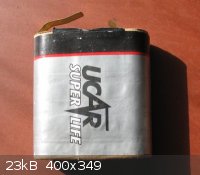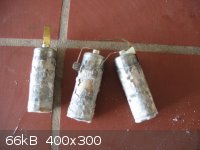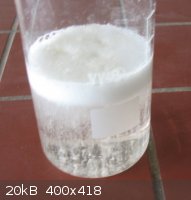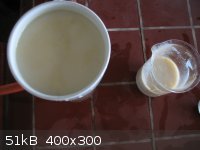Doktor Klawonn
Harmless

Posts: 29
Registered: 20-11-2010
Location: Europe
Member Is Offline
Mood: No Mood
|
|
manganese carbonate from spent zink carbon batteries
Introduction
Making manganese compounds from batteries has been discussed extensively on this forum [1]. While some of the procedures presented require the use of
corrosive chemicals such as sulfuric acid, some other methods call for handling large amount of gases like sulfur dioxide or nitrogen oxides. Here, I
like to present a method that uses rather harmless chemicals to produce manganese carbonate.
labware:
- gloves
- spent zinc-carbon-battries
- beaker 1000 mL
- beaker 2000 mL or several of a smaller size
chemicals:
- sodum hydrogen sulphate
- sodium bisulphite
- sodium carbonate
caution:
- do not breath in dust of manganese compounds
- during some stages of this process sulfur dioxide may be evolved, work outside or use a proper fume hood
experimental:

A spent zinc-carbon-battery (3R12) was weighed, opened and disassembled. [2] This on was completely corroded.

The black battery mass was weighed.[3]

The black mass was washed with water and then mixed into a solution of 22.5 g NaHSO<sub>3</sub> (0.22 moles) and 73 g
NaHSO<sub>4</sub> (0.61 moles) in 600 mL of cold water.[4] When preparing the solution, sulfur dioxide may be evolved. The beaker
containig the mixture was covered and allowed to stand over night. The mixture was filtered the next day.

To the clear colorless filtrate there was added 88 g sodium carbonate (0.84 moles) slowly and carefully so that it completely dissolves
(CO<sub>2</sub> is evolved. Caution! There may be sulfur dioxide evolved too in the beginning!). A white to beige precipitate was formed.
  
The precipitate is succion filtered through a Buchner funnel. The filter cake turns into a more brownish color as it is slowly oxidzed by air.
 
The filter cake was dried on a clay plate and then in a dessicator until constant weight.
Yield: 44.7 g of an ochre powder.

discussion:
Spent zinc-carbon-batteries contain reduced MnO<sub>2</sub>, something like MnO(OH), in the black battery mass. This MnO(OH) can be
dissolved in acids if a reducing agent is present.
2 MnO(OH) + NaHSO<sub>3</sub> + 3 NaHSO<sub>4</sub> --> 2 MnSO<sub>4</sub> + 2
Na<sub>2</sub>SO<sub>4</sub> + 3 H<sub>2</sub>O
NaHSO<sub>4</sub> acts as an acid, NaHSO<sub>3</sub> as a reducing agent. The resulting solution of
Mn<sup>2+</sup> ions reacts with sodium carbonate to MnCO<sub>3</sub>, which precipitates out of the solution.
MnSO<sub>4</sub> + Na<sub>2</sub>CO<sub>3</sub> --> MnCO<sub>3</sub> +
Na<sub>2</sub>SO<sub>4</sub>
further use:
MnCO<sub>3</sub> is suitable to prepare any other manganese salt.
remarks:
[1] Threads:
- MnO2 -> MnSO4; What is the best route?
- MnO2 from dead battery
- Strange manganese dioxide (?)
- Manganese dioxide- make or buy?
[2] The weight of these batteries varies. Some weigh 102 g, this one only 93,3 g.
[3] In order to adjust the amount of the chemicals as well as to calculate the yield of MnCO<sub>3</sub> later on.
[4] These amounts are calculated assuming a 60% content of MnO<sub>2</sub> or MnO(OH) respectively. This number was estimated in prior
experiments when larger amounts of the salts did not produce higher yields of MnCO<sub>3</sub>.
links:
- This procedure as a video
- disassembling the battery as a video
- Nurdrages video for making MnSO<sub>4</sub> from batteries
- removing paraffin from the carbon electrodes: they are impregnated
[Edited on 27-11-2010 by Doktor Klawonn]
[Edited on 27-11-2010 by Doktor Klawonn]
[Edited on 27-11-2010 by Doktor Klawonn]
[Edited on 27-11-2010 by Doktor Klawonn]
[Edited on 27-11-2010 by Doktor Klawonn]
|
|
|
bquirky
Hazard to Others
  
Posts: 316
Registered: 22-10-2008
Location: Perth Western Australia
Member Is Offline
Mood: No Mood
|
|
nice writeup and photos indeed !
|
|
|
Aqua_Fortis_100%
Hazard to Others
  
Posts: 302
Registered: 24-12-2006
Location: Brazil
Member Is Offline
Mood: †
|
|
Doktor Klawonn , nice writeup. This is very attractive to many people, since generally we have tons of these batteries laying around and would be nice
to use this material in our experiments.
But there is a problem, IMHO.. Did you washed the black mass only with water? If yes, I guess there is Zn contaminating your MnCO3.
BTW, I have +/- 2 Kg of tech grade MnO2, but Im gathering many batteries to obtain homemade MnO2 and compare it..
Part of my MnO2:

My MnCO3 (this was made by reacting unknow purity MnSO4 solution with Na2CO3, washing very well the ppt and drying):

"The secret of freedom lies in educating people, whereas the secret of tyranny is in keeping them ignorant."
|
|
|
Random
International Hazard
    
Posts: 1120
Registered: 7-5-2010
Location: In ur closet
Member Is Offline
Mood: Energetic
|
|
What are some interesting uses for mn carbonate and mno2. I have some but I don't know what to do with them 
|
|
|
Doktor Klawonn
Harmless

Posts: 29
Registered: 20-11-2010
Location: Europe
Member Is Offline
Mood: No Mood
|
|
Quote: Originally posted by Random  | What are some interesting uses for mn carbonate and mno2. I have some but I don't know what to do with them  |
From the carbonate, you can make the nitrate and use it for coating of electrodes (see thread "thoghts on anodes"). Or make the sulfate and try to
depose some manganese metal electrolytically (very tricky). From MnO2, you can try to make KMnO4. MnO2 is widely used as oxidant in organic chemistry
although it needs to be activated for some procedures.
|
|
|
kmno4
International Hazard
    
Posts: 1503
Registered: 1-6-2005
Location: Silly, stupid country
Member Is Offline
Mood: No Mood
|
|
Quote: Originally posted by Aqua_Fortis_100%  | Doktor Klawonn , nice writeup. This is very attractive to many people, since generally we have tons of these batteries laying around and would be nice
to use this material in our experiments.
But there is a problem, IMHO.. Did you washed the black mass only with water? If yes, I guess there is Zn contaminating your MnCO3.
|
Surely it is. My MnCO3 also prepared from used batteries was purified but still contains ~1% Zn (checked with X-met).
It is easy to check if there is some Zn contamination: small amout of MnCO3 treat with 10% NaOH for a longer time with stirring and filter it.
Next carefully add H2SO4 or HCl to filtrate to neutralize NaOH.
If Zn is present in larger amounts, then Zn(OH)2 will precipitate at pH ~6-7 and redissolve if more acid is added.
|
|
|